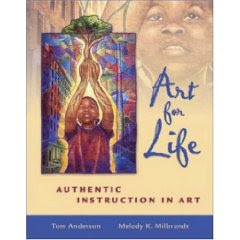Sandell, R. (2009). Using form+theme+context (FTC) for rebalancing 21st-century art education. Studies in Art Education. Retrieved September 6, 2009 from http://alumniconnections.com/olc/filelib/NAEA/cpages/9002/Library/UsingFTCStudies_Spring09_Sandell.pdf
“…all learners increasingly need 21st-century skills that rely on multiple forms of literacy, including visual literacy, which is to images what reading and writing are to words (Burmark, 2002)”
“Today’s students require capabilities that enable them to encode visual concepts through creating art and to decode meaning by responding to society’s images, ideas, and media which permeate our increasingly complex visual world (Sandell, 2003).”
“Despite how highly visual our world is, for many, art remains a mystery— people do not know how to dissect its meaning and “own” it purposefully in their lives.”
“(Daniel) Pink (2005) indicates that today’s learners will need to use six new senses: design (increasing the visual appeal and organization of things), story (communicating effectively through compelling narrative), symphony (synthesizing ideas, seeing the big picture and how the pieces fit together), empathy (seeing the world as others see it), play (creatively engaging in problem solving and inventive thinking), and meaning (uncovering, finding a sense of purpose, and making informed choices towards higher-order thinking skills and transformation).”
A New Tool for Balanced Visual Literacy in Art Education
“In embracing today’s standards for teaching studio art and art history in the context of contemporary visual culture, we need to help learners more fully understand art images, objects, and events, present and past, building a sense of relevance and significance in their lives.”
“Art = Form + Theme + Context”
“…form, or how the work “is,” we scrutinize the artist’s many structural decisions embedded in the creative process that leads to a final product”
“…theme, or what the work is about, we discern what the artist expresses through a selected overarching concept that addresses the Big or Enduring Idea (Walker, 2001; Stewart & Walker, 2005) along with relationships that reveal the artist’s expressive viewpoint connecting art to life.”
“…context(s), or when, where, by/for whom and why the art was created (and valued), we comprehend the authentic nature of the artwork by probing the conditions for and under which the art was created and valued as well as by considering the work under conditions from our perspectives in contemporary, foreign, or older cultures.”
“By distinguishing how the form and theme work together within specific contexts, we can comprehend art’s relevance and significance for the creator within his/her culture or society, which can lead to greater understanding and appreciation by the contemporary viewer”
“With contextual information, visual learners can perceive the intention and purpose of an artwork by identifying personal, social, cultural, historical, artistic, educational, political, spiritual, and other contexts that influence the creation and understanding of the work.”
“Rather than reactively reject the “infamous” elements of art and principles of design, we might proactively embrace a metaphorically bigger picture of art by balancing Form + Theme + Context.”
“Designed to activate thinking by generating and “mixing” information, the FTC Palette is a visual organizer that builds understanding, makes connections, and inspires deeper inquiry and creativity.”
“Rebalancing art and art education through the conceptual mapping approach to exploring art contained in the FTC Palette has the following characteristics: it is focused, dialectical, inclusive (comprehensive), connective, creative, and engaging.”
“The use of FTC emphasizes balance in making connections so that even inexperienced viewers can more fully address thematic relationships and contextual relevance while gaining a clearer understanding of artistic form.”
“By enlarging the visual thinking process, FTC considerations can help students create and respond to art that is authentic, deep, and meaningful.”
“…we might note Modernism as emphasizing form, Postmodernism as emphasizing theme, and Visual Culture as emphasizing context.”
“…using Form+Theme+Context inclusively combines the vital aspects of modernism, postmodernism, and visual culture while ensuring each of their important contributions and place in our contemporary understanding of art and visual culture.”
“…the Bill & Melinda Gates Foundation’s (n.d.) “new 3Rs” consisting of “Rigor, Relevance and Relationships” used to address high school reform (McCallum, 2007).”
“These 3Rs are equally pertinent to deepening the power of arts learning through FTC when focusing on the rigor of skill and structure (form), understanding and establishing meaningful relationships (theme), and appreciation of significance and relevance (context).”
Subscribe to:
Post Comments (Atom)






No comments:
Post a Comment